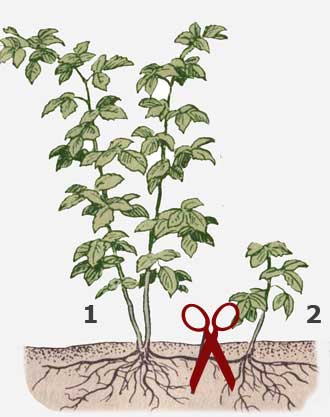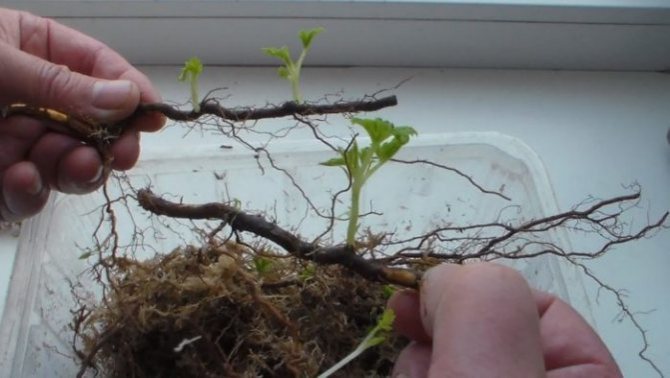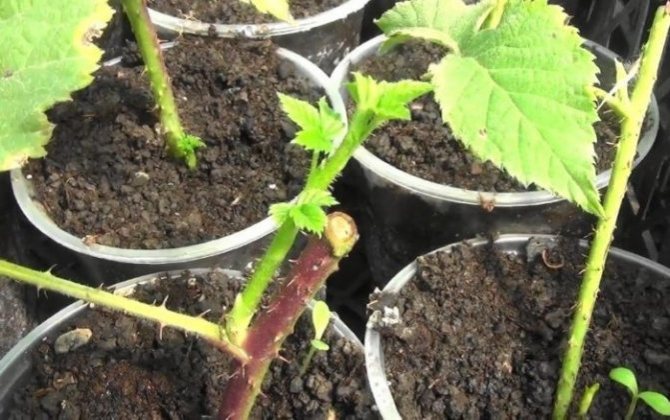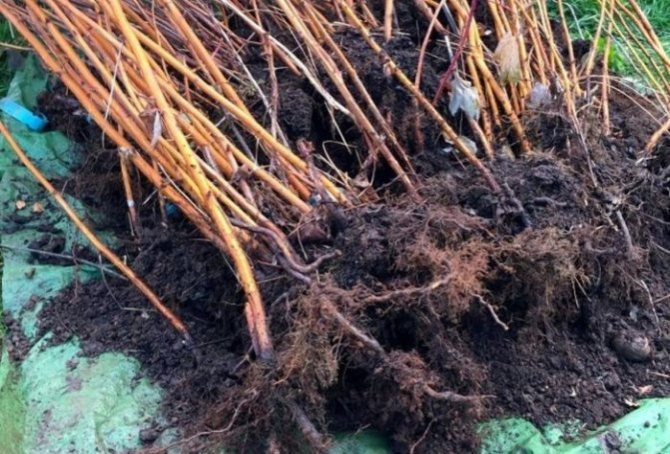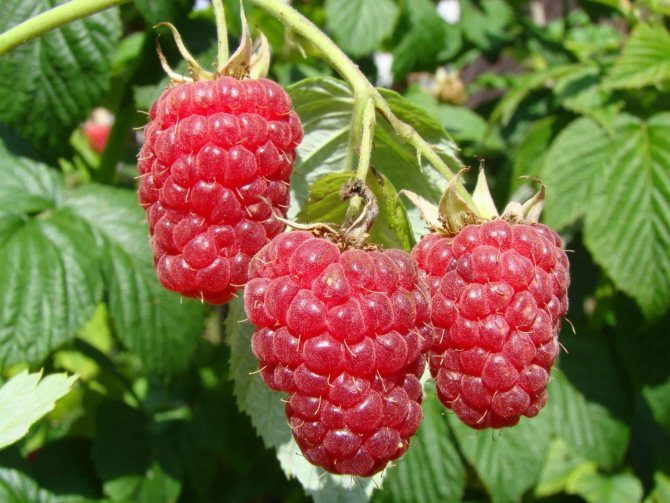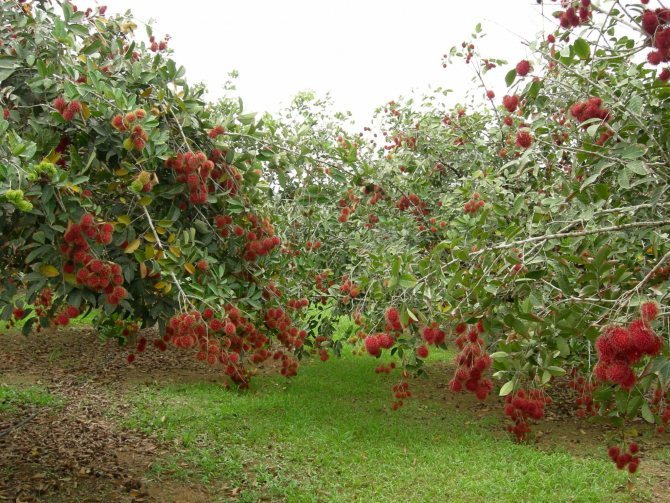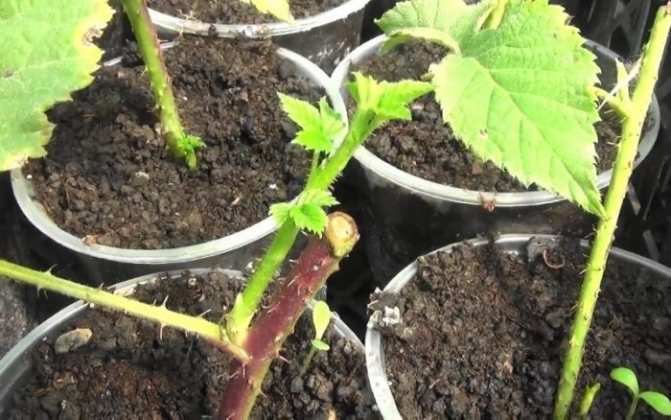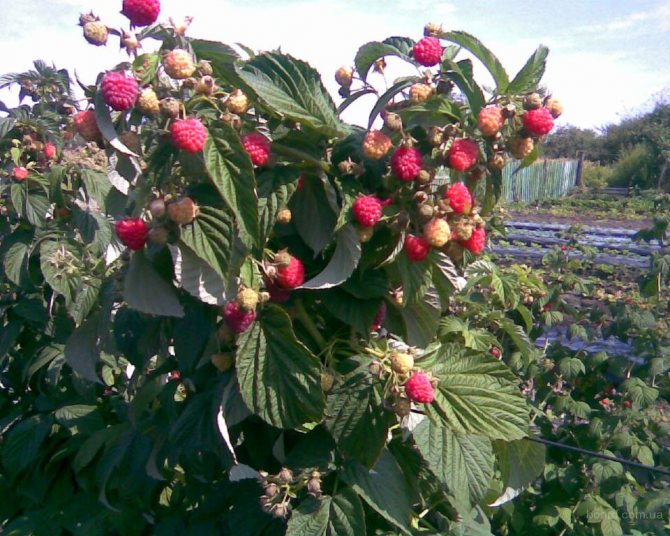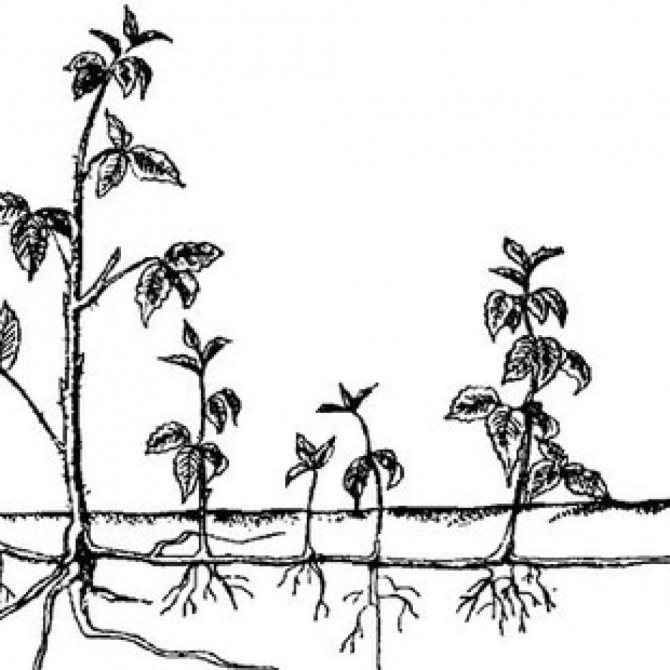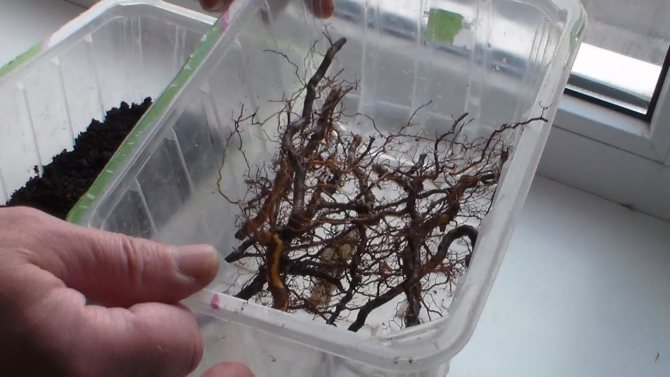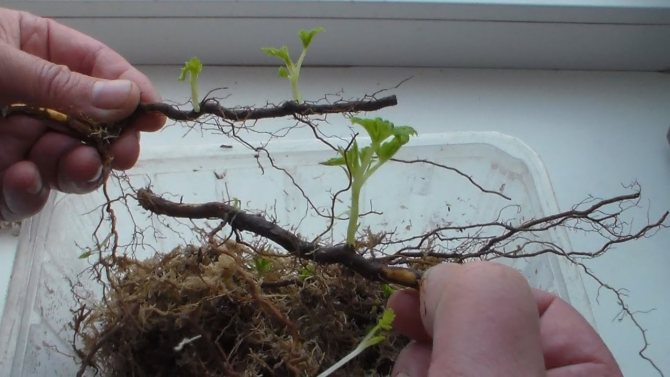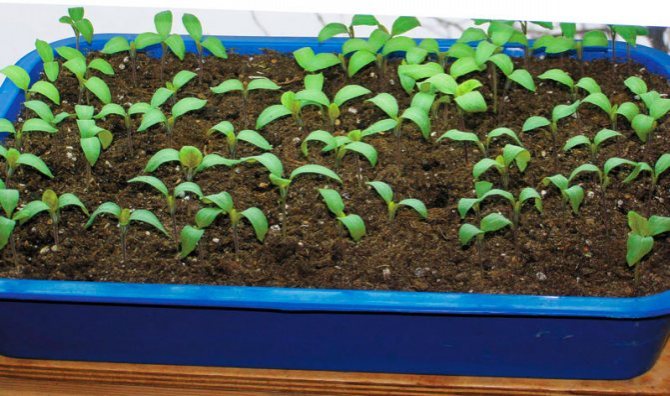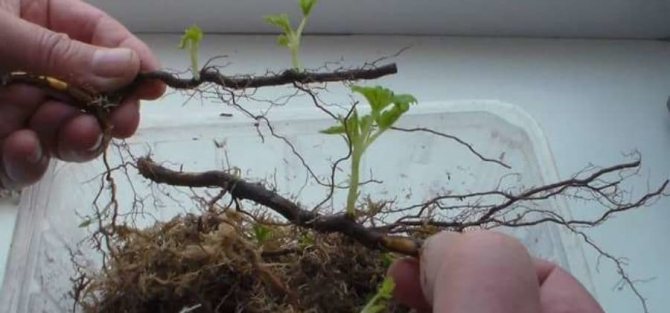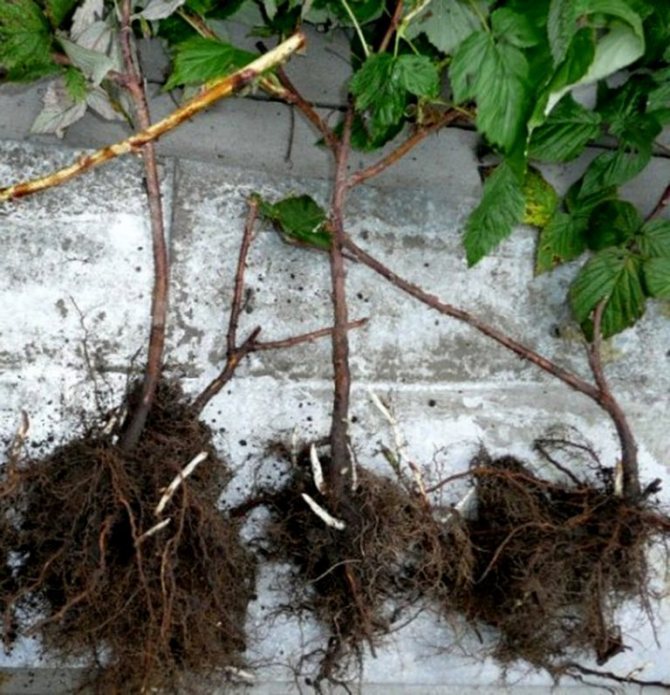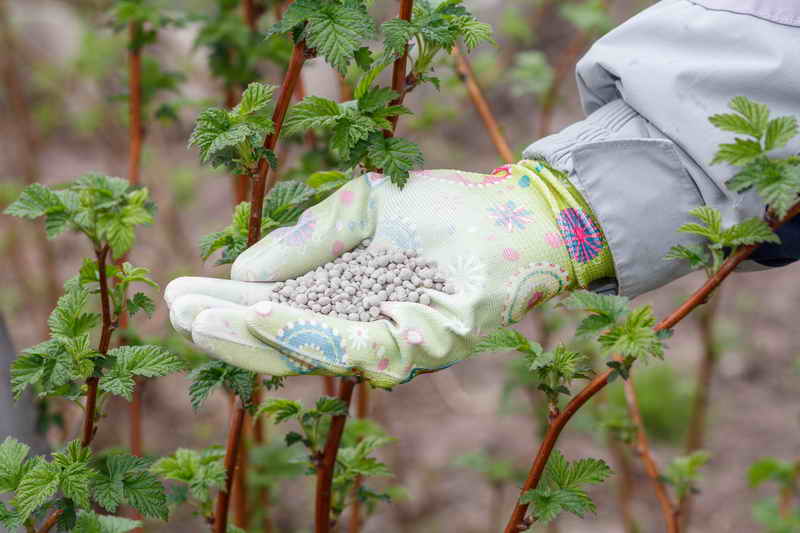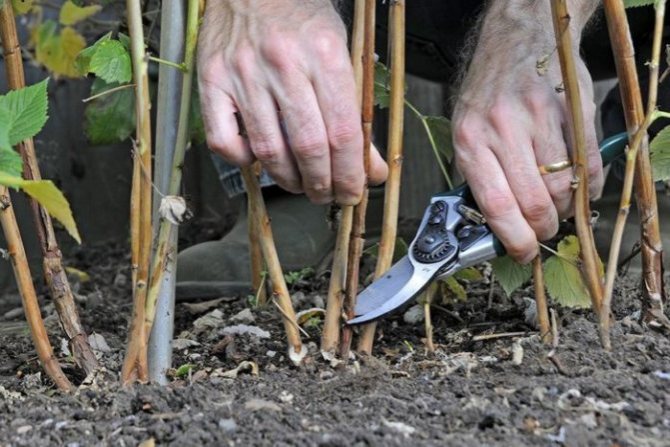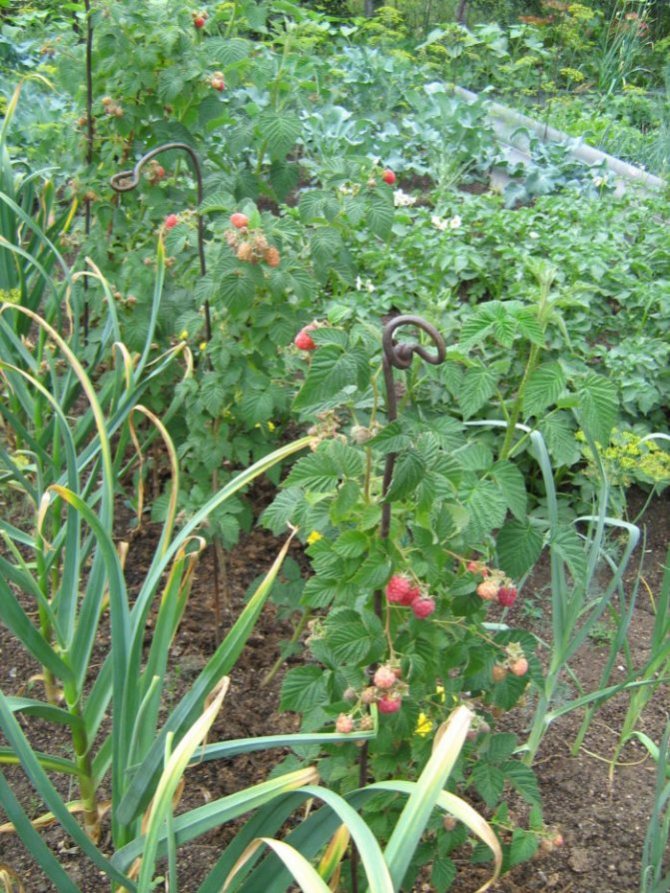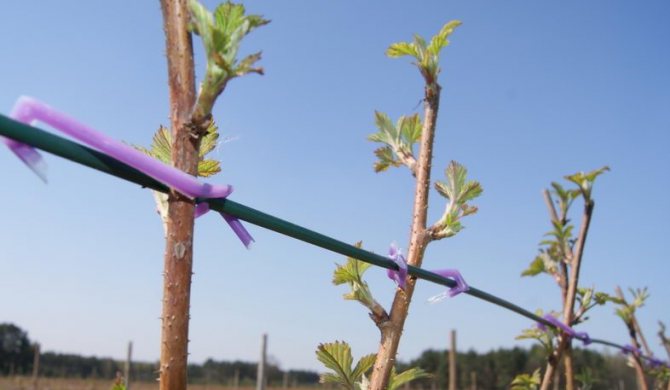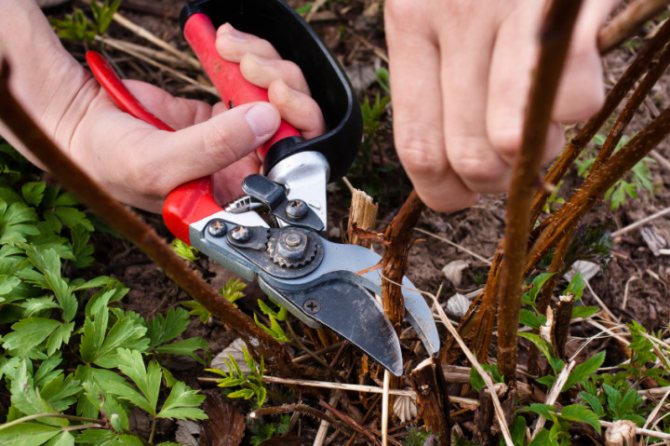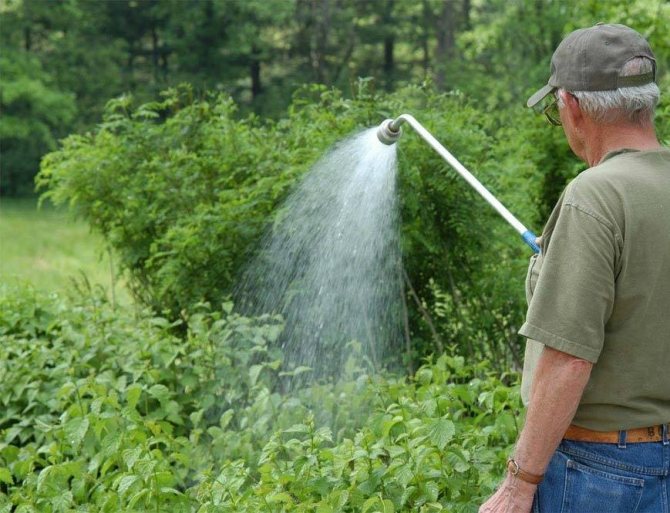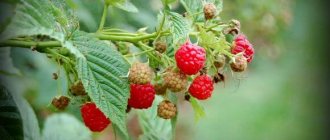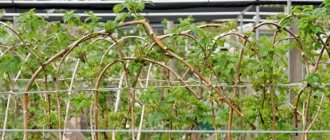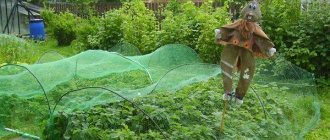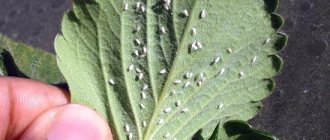Raspberry planting usually begins with several seedlings. The desire of the gardener to increase its size as quickly as possible is quite understandable, especially when it comes to elite high-yielding varieties. Reproduction of raspberries in a vegetative way allows you to solve this problem in a fairly short time.
Raspberry is a semi-shrub plant with a branched rhizome full of dormant buds. This feature determines the main methods of its reproduction - root suckers and cuttings.
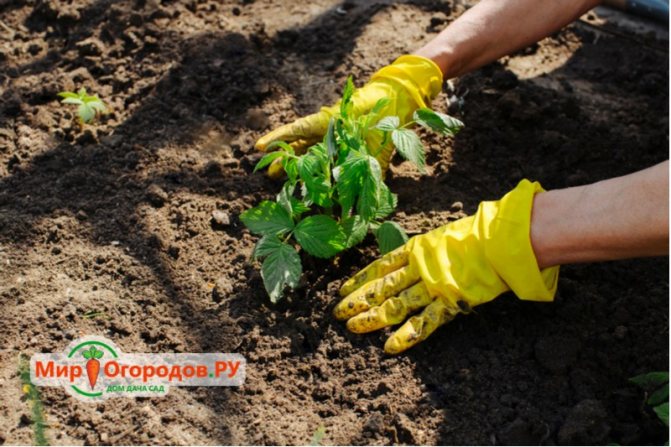
How to properly propagate raspberries at home?
Despite the simplicity of this activity, it is worth knowing some of the nuances of how to properly propagate raspberries at home, namely:
- Don't be afraid to experiment with different breeding methods and at different times.
- Decide on the purpose of growing: for own needs or for further implementation on the market.
- Check out the varietal varieties and select the most suitable and productive varieties for your region. Focus on criteria such as fertility, taste and size of berries, demanding care, period and time of fruiting, resistance to diseases and pest attacks.
- Choose the right site: it should be lighted, with well-drained soil. The optimum temperature regime for growing a crop is + 22 ... + 30 ° С. The plots should not be low, waterlogged, since the berry culture does not tolerate stagnant water. Taking these factors into account will help not only to acquire a raspberry plantation, but also to get a good harvest.
- Distances should be observed when landing.: 2 m between planting pits, and approximately 0.75 m between rows.
- In order for the plant to root quickly and efficiently, place compost on the bottom of the planting hole, then fertile soil and wood ash.
- Stock up on the necessary tools: shovel, pruner, knife, bags... If you are going to cut cuttings for winter storage, then also prepare the amount of sand, peat or sawdust you need, and containers in which the cuttings will be stored. For immediate planting, you will need containers filled with fertile soil and a film for covering in order to create a greenhouse effect.
- Choose the best breeding method, focusing on varietal preferences and specifics, the quality of planting material and environmental conditions. Also consider the time of year.
Did you know? Raspberry roots can reach 10 years of age, while their stems live only 1 year: the old stem dies off and a new one grows.
Reproduction of honeysuckle. Methods and subtleties of reproduction of honeysuckle
Edible honeysuckle literally burst into Russian gardens. Amateurs vying with each other start this berry culture - tasty, healing, extremely plastic and winter-hardy. If it is problematic to purchase planting material in your region, you can grow the seedlings yourself. Vegetative reproduction of honeysuckle at home ensures the preservation of the varietal characteristics of the parent specimen, good survival of the culture, and the rejuvenation of old bushes.
Edible honeysuckle is one of the earliest temperate berries
Conditions for successful breeding of honeysuckle
Fired up with ideas to start honeysuckle, but not fully understanding the intricacies of its cultivation, gardeners are often disillusioned with culture. It seems that they did everything right, they provided care, and the plant refuses to bear fruit or gives few berries, and even those are bitter. To get high-quality planting material, and then a fruitful berry, it is not enough to know how to propagate honeysuckle. An obligatory plus to the technique is knowledge of the biological characteristics of the plant.
- The most important condition for the yield and taste of berries is cross-pollination of different varieties of honeysuckle (at least 3-4) located in close proximity to each other. It is desirable that in the garden collection there are varieties with different ripening periods, dessert, sweet and sour, with a piquant taste.
- For high yields, plant your shrub in an open, sunny location. The preferred landing pattern is not in rows, but in curtains. The large blooming area attracts bumblebees, and these are the most effective pollinators of the tubular honeysuckle flowers.
- For vegetative propagation, choose young uterine honeysuckle bushes with good vigor and no visible signs of disease.
- At the first stage of reproduction, the main task is to stimulate root formation. This requires a favorable thermal regime, high soil and air humidity, shading from the bright sun. In fact, these are the greenhouse conditions that are necessary to get out of the nascent life.
- Grown up seedlings need growing, hardening, adaptation to growing conditions in an open environment. During this period, a viable root system is formed, the plant acquires immunity. The optimum age for transplanting a seedling to a permanent place is 2-3 years.
Why do raspberries sprout and take root around the site?
The spread of raspberries is due to the peculiarities of its reproduction.
The dynamics of reproduction over the years is as follows:
- A seedling grown from a drupe acquires a rhizome and a stem.
- In the second year, fruit branches are formed on the shoot, 2-3 replacement shoots on the rhizome, and daughter shoots on the roots. By the fall of the same year, the offspring grow their own rhizome and turn into independent plants. By the end of the second year, the raspberry tree is a group of annuals and biennials with a common root system.
- In the third year, the maternal and daughter shoots acquire fruit branches, and the rhizomes acquire replacement shoots.
Then the process is repeated. The raspberry bush grows very quickly, replenishing with new shoots every season. This happens until the mother plant dies. His death splits the raspberry plant into several groups, each of which continues to develop independently.
Seasonal ways
There is no definite answer to the question of what time of year is the best for raspberry breeding, since the process can be carried out in spring, summer and autumn. In this case, you should take into account which methods are optimal for breeding in a particular season.
So, spring reproduction should be carried out before the growing season begins, resorting to the seed method, by the methods of offspring, dividing the bush, lateral, root or green cuttings.
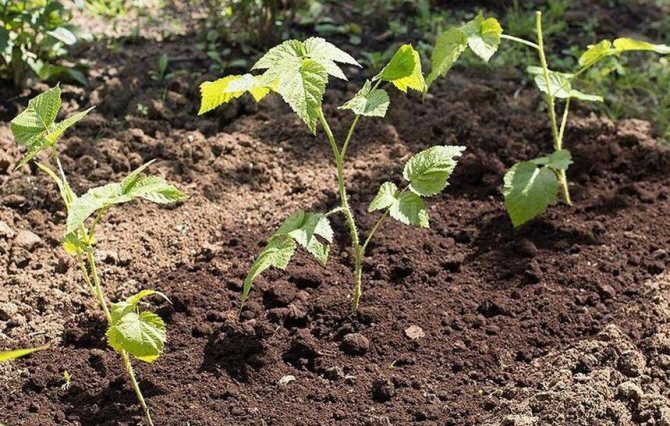

In summer, raspberries are advised to be planted using the green cuttings (young shoots) method. In the fall, experienced gardeners recommend resorting to grafting of adult bushes, or dividing them.
Care after landing
Regardless of which of the propagation methods was chosen, the seedlings after transplantation always need care and attention. At first, you need to carefully monitor them, water them so that the soil is moist. Moreover, it should not be too waterlogged, in such a ground the roots can rot. It is also impossible to overdry it, in which case the plants will not develop normally. For watering, it is better to use a watering can, rather than a hose, so as not to wash away the soil near the plants with a stream.A good option would be to use a drip irrigation system.
Do not forget about loosening, they must be carried out carefully, not going too deep, so as not to hurt the growing roots. It is necessary to remove weeds in a timely manner so that they do not stun low raspberry plants. It is possible to reduce the labor intensity of growing seedlings in a garden plot by covering the soil surface around them with mulch. Thus, the number of watering will be reduced, there will be no need for loosening and weeding.
It is necessary to feed the cuttings and offspring immediately after planting. Nitroammophoska is suitable - for 1 sq. m. requires 1 tbsp. l. fertilizers. Before watering with a solution of chemical fertilizers, the soil must first be watered with plain water. In addition to mineral fertilizers, for feeding raspberries, you can use an infusion of manure (1 to 10) or herbal infusions from a mixture of weeds, freshly cut grass, tops of root crops.
For the winter, the plants planted this year must be covered: the soil must be mulched with hay, fallen leaves, sawdust, straw, needles. In the northern regions, it is necessary to use a more reliable shelter - spruce branches, roofing felt or special dense agrofibre. In the spring, we must not forget to remove it with the onset of heat, so that the buds that begin to bloom do not die under it.
Adding an article to a new collection
To plant raspberries in the garden, just one seedling is enough. Everything else is a matter of technology. We figure out what methods of breeding raspberries are the most effective.
Raspberries are a good plant for gardening experiments. It multiplies easily and takes root well in a new place. There are several effective ways to propagate raspberries.
Features and Benefits
Gardeners have different approaches to raspberry propagation: some prefer spring plantings, while others resort to summer or autumn plantings, choosing convenient methods for themselves and effective for plants. In many ways, the choice of planting time and methods depends on the plant variety and climatic conditions in the region.
Root cuttings
Root cuttings are parts of roots with lateral branches that are capable of further growth separately from the main rhizome. The thickness of such lateral roots should be more than 2 mm, or better, more than 5 mm, and the length should be 10-15 cm, leaving 1-2 buds.
Important! Despite the many ways of planting raspberries and their ability to reproduce at any time of the year, it is still optimal to plant the crop in spring, since at this time it is most resistant to stress.
To get a root cutting, you need to dig out the soil 40 cm from the center of the bush. The lateral branches are carefully excavated, separated from the rhizome and pulled out, trying to preserve all the roots as much as possible.
If the cuttings are cut in the spring, then they are placed in grooves previously prepared in fertile loose soil., the depth of which is 5–10 cm. Cuttings are folded flat and watered abundantly. It is recommended to cover the planting with a film to create a greenhouse effect and maintain a humidity of 90–92%. The film is removed when green shoots appear on the cuttings.
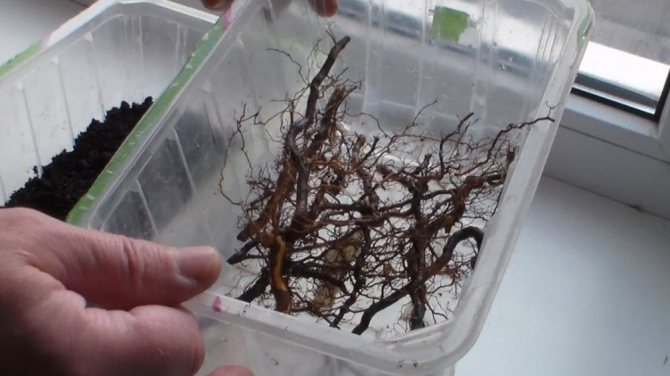

Features of root cuttings
Reception of root cuttings is relevant due to the formation of buds on the rhizome. Shoots are subsequently formed from them.
The technology is used most often when the stems are damaged by diseases or pests.
Cutting consists in:
- choosing bushes to be removed or replanted;
- selection of healthy mother material - roots up to 3 cm in diameter;
- cutting the rhizome into 10-15 cm pieces.
In spring or summer, seedlings are immediately placed in the ground with pre-made furrows 5-7 cm deep. The future plantation is covered with soil and thoroughly watered. The resulting seedlings are transplanted. Autumn blanks are stored in boxes with moistened sand until March.
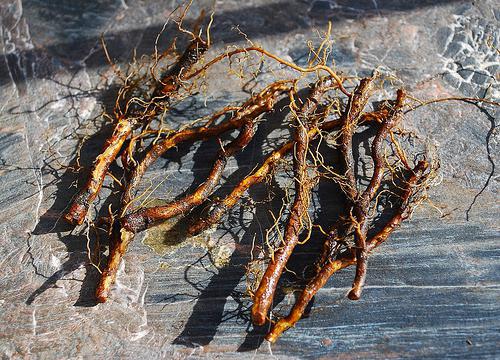

Features of the reproduction of raspberries
Raspberry is a characteristic representative of perennial shrubs, however, among ordinary shrubs, it has significant features. Firstly, its aboveground part grows for only two years, after which it dries up and dies off. In the first year, it forms fruit buds, from which twigs with flowers and then berries appear in the second year. Secondly, the underground part can live for more than a dozen years, but in conditions of cultivation of culture, including in summer cottages, we can talk about about 8-10 years of existence of raspberries in one place.
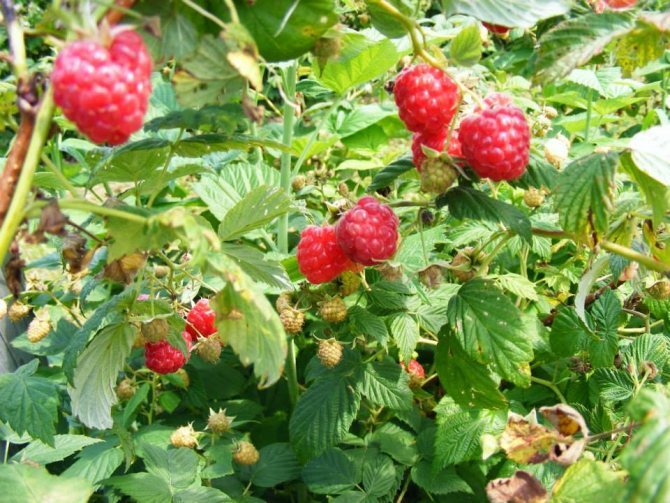

Common raspberries bear fruit on the shoots of the second year of life
The root system of raspberries is close enough to the surface of the earth (from 10 to 40 cm), so the culture is very demanding on the amount of moisture and requires constant watering. On light soils, the roots penetrate deeper (some - up to one and a half meters), on heavier soils - closer to the surface of the earth. The roots extend from the base of the bush for long distances - up to two meters, capturing more and more new areas.
Every year, in summer, growth buds are formed on the rhizomes, from which spring shoots appear the next year. The raspberry bush grows and reproduces not only by replacing shoots, but also by root "offshoots" - daughter plants. Soon, the offspring become independent plants, gaining their own root system. Thus, raspberries may seem like an "eternal", self-replicating plant. However, with the aging of the bush, the number of replacement shoots decreases, the bush hibernates worse and, in the end, dies.
Soil preparation
To always have a big and tasty harvest, plant raspberries in an area that is well lit by the sun, but at the same time protected from drafts and cold winds.
Raspberries do not like acidic soils and do not tolerate high standing waters. It is best to choose light soils, loam. Otherwise, the composition of the soil will have to be compensated for with mineral and organic fertilizers, ash, dolomite flour.
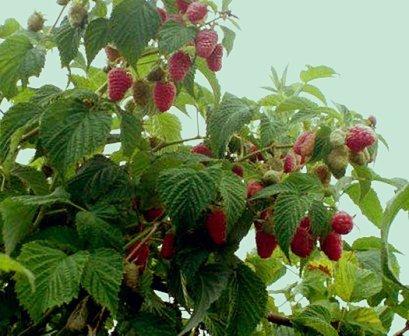

Since this is a perennial plant and it is transplanted quite rarely, at about the 15th year of life in the same place, then depending on how good the soil is under the berry, the quantitative you will receive yields. Important points:
- Raspberry roots are located about 30 cm deep in the ground, therefore, for their good development, the soil, of course, should be enriched with nutrients and the necessary moisture.
- The soil should be loose, structural, then enough oxygen will penetrate into it for good growth of the rhizome.
- In addition, the soil should perfectly transmit moisture and bring it to the roots. Loamy soils and very crumbly, in which there is nothing nutritious, raspberries are very often "killed", and, accordingly, they do not give any harvest.
More on the topic: How to propagate raspberry cuttings of remontant varieties
If you have just such a soil, then you should fertilize it with high quality before planting new seedlings. It is necessary to apply about 10 kg per 1 m2 of organic fertilizer for better growth and good raspberry flavor.
Places for planting plants should be chosen with a flat surface, which are protected from the wind by buildings, a fence or other large plantings. Before planting raspberries, the soil is plowed deeply and at the same time fertilized with compost, which was prepared in advance.
Compost is easy to make from household waste that accumulates in every home. These can be ordinary food leftovers, cleaning vegetables, weeds, wood waste, fallen leaves.
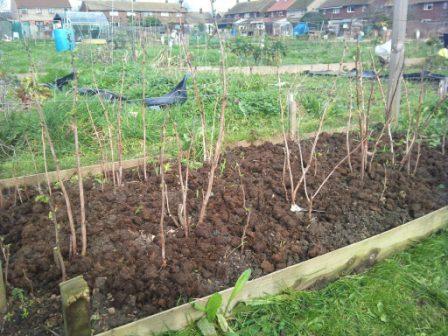

Bush care
Caring for remontant varieties is somewhat different from growing ordinary raspberries. This is especially true for watering, garter, pruning and fertilizing the bush.
Watering and fertilizing
Watering raspberries is necessary during the period of active growth of leaves and shoots, during flowering and at the time of active fruiting.Watering should be abundant to moisten the soil 0.5 m deep. But the rest of the time the bush has enough natural moisture.
In early spring, remontant raspberries are fed with nitrogen fertilizers. These include:
- urea;
- ammonium nitrate;
- ammonium sulfate.
Instead, you can use a slurry solution prepared at the rate of 1 liter of slurry per bucket of water. This volume is enough to fertilize 2 sq. m landings. For autumn feeding, it is better to use superphosphate or nitroammophoska, but nitrogen fertilizers cannot be used.
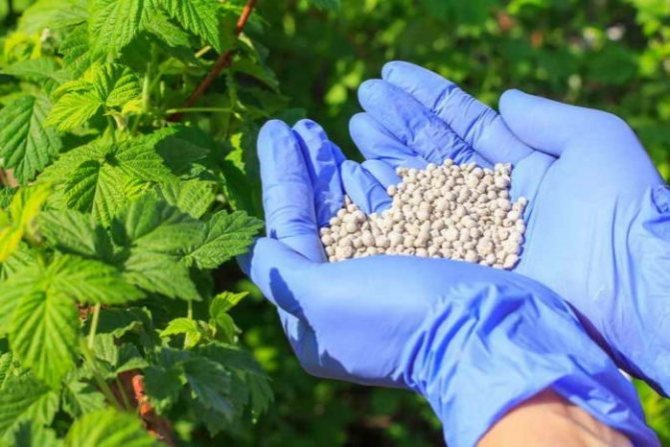

Garter
Repaired raspberry varieties are characterized by rapid growth of shoots, long-term fruiting and require a mandatory garter. To do this, you can use ordinary supports to which the shoots collected together are tied. This garter method is suitable for bush planting. With the trench method of growing raspberries, they are tied to a trellis, in 2-4 places, at different heights.
Young shoots or shoots
The overgrowth reproduction method is used in large nurseries. It differs from the above method in that the shoots for seedlings are not cut out of each bush, but are formed within two years instead of a bush in large quantities.
Raspberries are planted according to the scheme 1x2.5 m. The goal of the first year of growth is to obtain a large volume of roots. In the spring of the second year, a sharply sharpened tool removes the entire aerial part and 3-5 cm of roots from the center of the bush. Do this immediately after the snow melts.
From the roots remaining in the soil in the adventitious buds, often up to 20 pieces of offspring-seedlings develop. How quickly quality seedlings grow depends on proper care. It is necessary to carry out the following procedures:
- watering as needed;
- 3-4 weeding of weeds;
- 3 nitrogen fertilizers;
- 2-3 sprays from a raspberry fly;
- 3-4 loosening.
Saplings are dug up in the fall. The next year, a second crop of seedlings grows between the rows from the remaining roots.
Root cuttings
Reproduction of raspberries by roots allows you to get planting material in private nurseries and private farms. This method of vegetative propagation is effective, it resembles the conveyor method.
Important! As a result of this method, the most powerful seedlings are obtained.
Cuttings 10-20 cm long and 1-2 mm thick are used. They are planted in loose peat soil. Planting material is placed in furrows 20 cm deep every 10 cm.The planting is trampled down and watered.
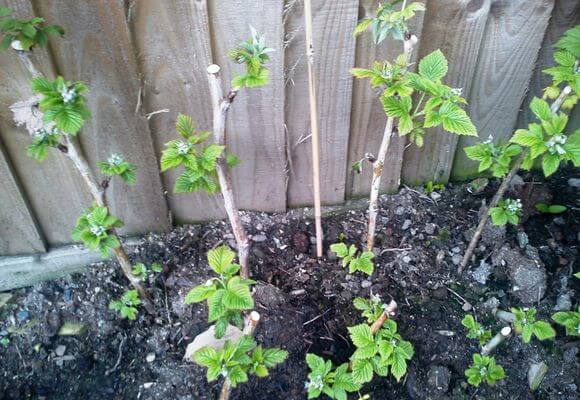

At the beginning of May, they make the first of three dressings. Take a shovel of fresh manure and 2 tbsp for a bucket of water. l. saltpeter. Against root rot, any specialized preparations or copper oxychloride are added to the solution. The next two dressings are done every 2 weeks.
During the summer, spraying is done against pests and diseases. Watering is done according to needs.
They begin to dig out seedlings for planting in a permanent place in mid-September. At this time, they grow 1.5-2 m. The roots of the seedlings are shaken off the ground. By cutting off long roots, new roots are obtained, which are immediately planted again to obtain new seedlings.
Black and remontant berries
Each variety of raspberries differs in the way of reproduction... In a black berry, closer to autumn, the tips of the branches tilt, and small leaves and loops grow on them. The branches must be cut with a sharp knife and transplanted together with the ground to another place. The most suitable time of the year for this procedure is autumn, but you can do it in the spring as well.
The repairing raspberry variety differs in that it produces very few young shoots. It is best to cut such a plant in the fall, using root cuttings. Usually branches on the root grow on the side, they are suitable for reproduction. These cuttings are harvested in the fall. They are wrapped in cloth, then the roots are immersed in wet sand, stored in a cellar in winter. In the spring, this material is taken out and planted in trenches.
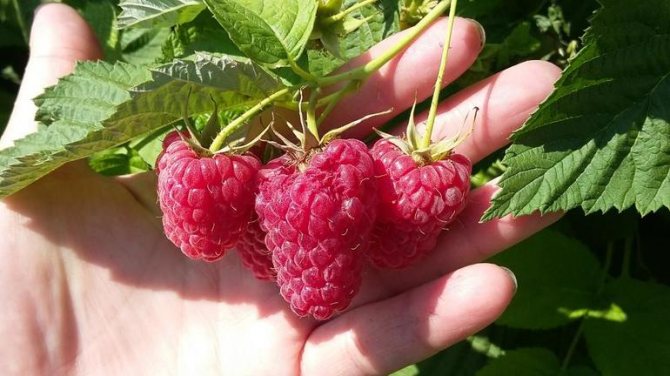

Above the plants, you need to make a greenhouse from plastic wrap. Sometimes it is necessary to open it slightly so that the cuttings are ventilated. When they take root well and new shoots begin to grow on them, the film should be removed.
If young shoots of raspberries were in a greenhouse, but not all have developed, then the weak are left for further growth until the next season, and the strongest are transplanted to a permanent place of growth. You can propagate remontant raspberries in the fall using root segments. To do this, follow these steps:
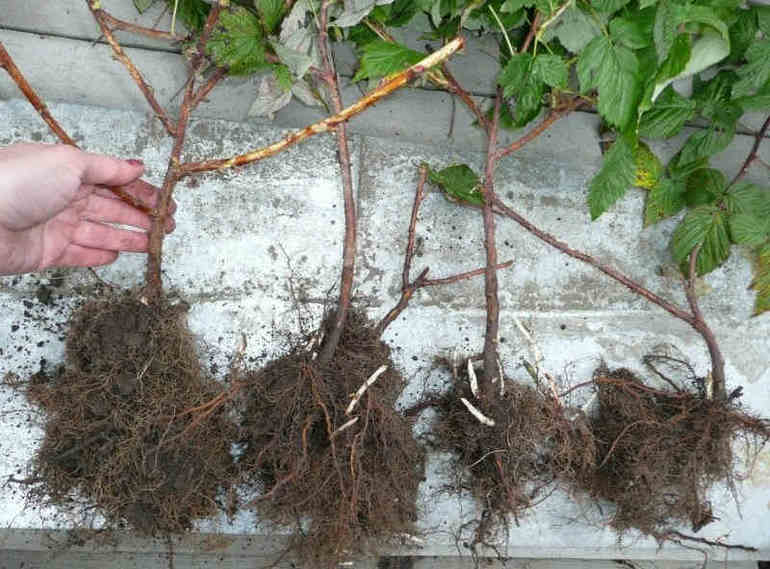

- It is necessary to take a whole root immediately after the appearance of shoots on it. They are divided, leaving a small root at least 5 cm long.
- The shoots should be transplanted into separate containers. To do this, the container is filled with peat, mineral fertilizers and coconut fibers.
- As soon as the plants take root and begin to develop, it is recommended to plant them in the soil shortly before the autumn frosts.
In the spring, hardening should be done so that the cuttings can be planted in open ground, bypassing greenhouses. First, they are taken out to the balcony, where the temperature is lowered to 1-2 ° C. Initially, the plants are kept for about 5 minutes, on the next day - up to 10. So gradually it is necessary to bring the time to 1 hour. This procedure will harden young seedlings, so that they can easily develop in the open field.
This variety can also be propagated using green cuttings. They are cut off at the beginning of summer with a sharp knife and immersed in a liquid to which a root growth stimulant is added. For this purpose, it is recommended to use Kornevin or Heteroauxin.
The ends of the appendages should be in the solution. They are kept in it for about 18 hours, then transplanted into a greenhouse or greenhouse. For more root formation, it is advisable to plant cuttings at an inclination of about 45 degrees, keeping a distance of 10-15 cm from each other.
Methods for harvesting green cuttings
Cutting of green cuttings is carried out in May - early June. Experienced gardeners use several techniques.
1 way
Work with this year's shoots:
- Cut 15-20 cm from the crown at an angle of 45 degrees.
- The leaves are removed from the bottom, leaving only the "factory" - 2 upper leaves.
- The upper part of the cutting is removed with a secateurs.
- In the lower part, using a knife, make longitudinal notches up to 5 cm in length.
The workpieces are placed in a root-forming solution, fermented nettle tincture, honey solution or aloe juice combined with water. The lower sections are treated with heteroauxin or another acid. It is first dissolved in alcohol, then water is added.
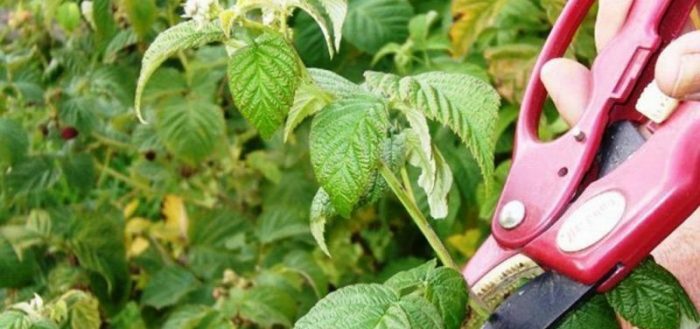

You can use 200 grams of heteroauxin per liter of hot water. Cuttings are soaked in the solution for 15-18 hours, planted in the ground and watered with this liquid.
The green stalk should be immersed in the solution at a spacing of the notches.
2 way
The strongest and healthiest shoots of this year are taken. Divide them into pieces 7-10 cm long with buds. Before planting in a greenhouse, soil or greenhouse, the material is treated with growth accelerators.
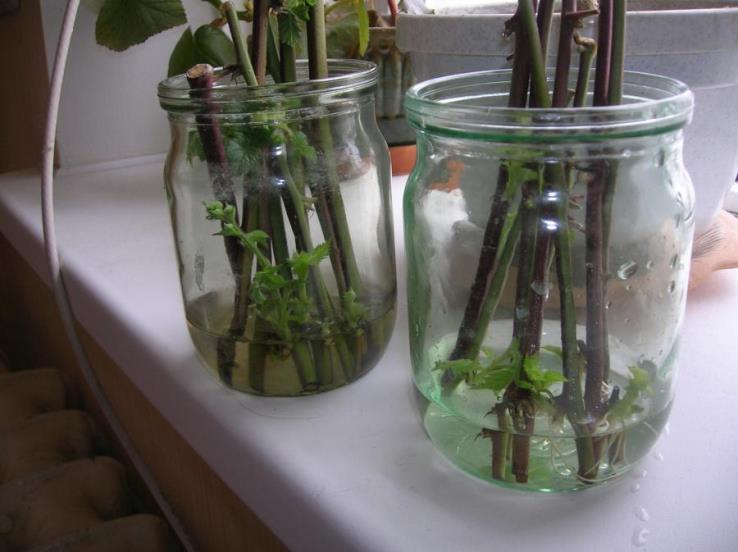

3 way
Designed exclusively for raspberries and provides for cutting green "nettles", which have high growth activity:
- Shoots with a barely formed leaf rosette are chosen.
- With the help of a pruner or a knife, the offspring is cut off, rising 4-5 cm from the ground, together with the etiolated (light) part.
- The material is immediately planted in the soil.
- The bottom cut is sprinkled with charcoal so that it does not rot.
Gardeners recommend making harvesting on a cloudy day or early in the morning - the sheets contain a lot of moisture.
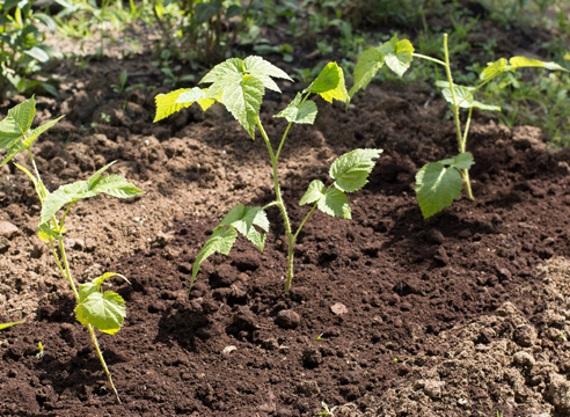

Planting and breeding raspberries by cuttings - choosing the right time
Agricultural work is carried out in all seasons except winter.
Spring and summer cuttings of raspberries
The warming period is not a shock for the culture. In sunny weather, cuttings grow faster into the soil.
Use only cuts with part of the root system.
The workpiece technology is as follows:
- From the young shoots that have appeared this season, cuttings 8-10 cm long with several buds are cut. The edge is trimmed with pruning shears.
- Small cuts are made 2-3 mm deep and 2-3 cm long.
- The workpieces are kept in a solution that stimulates root growth.
- Dig a hole and cover the cutting of fertile soil to the level of the root collar.
- The raspberries are watered and sheltered for 7 days.
- After the growth of green mass, fertilizing with potassium, nitrogen and phosphorus is carried out.
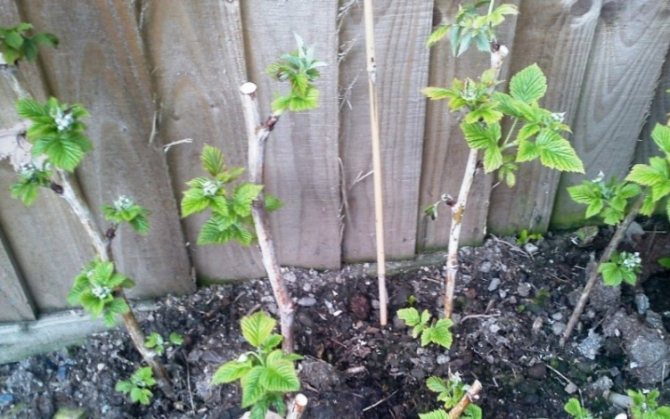

The plant will bear fruit one year after planting. In summer, they work with young shoots that have not yet become lignified - they have a great tendency to root. The summer technique has several features:
- green material is not stored for a long time, since it contains fewer nutrients;
- cuttings must be treated with stimulants in order to exclude decay and drying out;
- the workpieces are cut with a pruner near the ground or at a depth of 1 cm.
The stem is kept in a root stimulator for 12 hours, then it is planted under a film. The greenhouse is the optimal environment for the rooting and growth of the seedling.
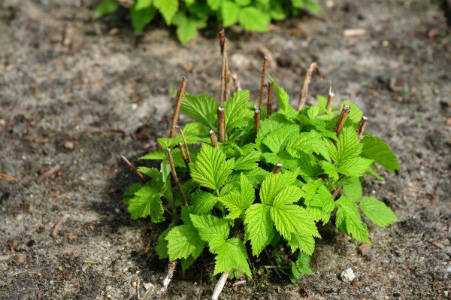

Autumn cuttings of raspberries
In the fall, you only need to work with dark brown plants without sheets. The algorithm provides for the following actions:
- Cuttings are cut 25-30 cm in length.
- Stratification is performed - the blanks are wrapped in paper and placed in a bag. Then they are placed in a wooden box with wet sand and sprinkled on top with another layer of sand.
- The blanks are stored until the end of winter with periodic checks of the moisture content of the sand.
- After unpacking the material in February-March, it is tied into bunches of 12-15 pieces. and soaked in a root stimulant for 12 hours.
- Prepare a solution of 1 tsp. sugar and 1 liter of thawed settled water.
- The cuttings are placed in a container, covered with a bag and placed in a room with a temperature of plus 24-26 degrees.
- After the roots appear, the shoots are transplanted into cut 2-liter bottles with soil mixture.
Use regular melt water - no special preparations need to be added to it.
Before planting, the seedlings are hardened. Indoors, the temperature gradually decreases by 2 degrees, then the material is taken out into the open air, increasing the time by 5-10 minutes daily. Disembarkation is carried out together with an earthen clod from a bottle.
